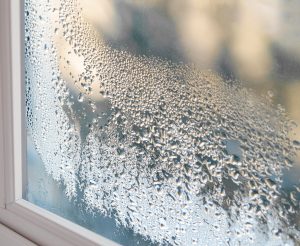Should I Be Worried About That Condensation on My Windows?
 If you take a look at your home’s windows and doors in winter, you may notice condensation. As temperatures drop, it often appears on the inside and outside of these surfaces.
If you take a look at your home’s windows and doors in winter, you may notice condensation. As temperatures drop, it often appears on the inside and outside of these surfaces.
Here’s what you need to know about why condensation occurs, when it matters and what you can do about it:
Interior Condensation – When the heat is on inside the home in wintertime, a certain amount of humidity feels good — we breathe easier, our skin is less dry and there’s less static in the air. This is fine usually, but when temperatures outside get extremely low, problems can arise. Under these circumstances, humidity can generate condensation on your windows — whether they’re old or new — and this should be managed.
While there’s no problem with condensation on the window glass itself, (except for the fact that visibility can be obscured) that condensation could affect wood trim around the windows and lead to mold and rot. Perhaps even worse, it could be an indicator that condensation is also occurring within your walls, which can lead to unhealthy mold.
Unfortunately, the most common sources of home humidity are everyday parts of life, including showers, cooking, doing laundry and even fish tanks. However, if you see condensation on your windows there are two actions that experts recommend. One, if you have a humidifier, turn it down. The second, use a dehumidifier.
Exterior Condensation – Exterior condensation occurs when the dew point temperature approaches the outside air temperature. When the air is saturated and can’t hold any more moisture, water vapor forms droplets on surfaces — including your roof, siding, windows and doors.
If you have energy-efficient windows, you may notice exterior condensation occur more than you did when you had older, less energy-efficient windows that allowed warmth from inside the home to reach the outside glass pane and dissipate the condensation. Unlike with interior condensation, there’s nothing to worry about in the case of exterior condensation. Moisture on the outside pane of glass is normal and a good sign that your windows are functioning correctly to prevent warmth from reaching the outside glass. The condensation will dissipate when the outside air temperature rises.
Next Steps – If there’s no condensation on the exterior of your windows but there’s moisture on adjacent exterior surfaces, this would be a good indicator that it’s time for new windows. Also, if you get constant internal condensation on your windows in very cold weather and your humidity is low, then upgrading to a more thermally efficient window would be a good idea.
Look for high-performing replacement windows with the latest technological advances that offer maximum efficiency and comfort. Third-party recognition for a particular brand or product is a strong indicator that you’re investing in a quality product. A recent “Remodeling” magazine survey of remodeling contractors ranked ProVia vinyl windows as number one in window quality in part because of their features that are tested against the most stringent requirements for air and water infiltration.
This winter, pay attention to your home windows, glass doors and other surfaces. Understanding the ins and outs of interior and exterior condensation can help you address potential issues. (StatePoint)
Susan Brewer Service First Real Estate (636)936-8600
Published on 2019-12-30 14:53:48

